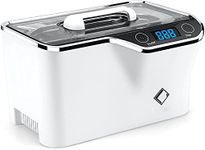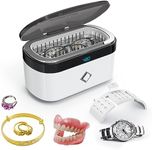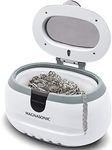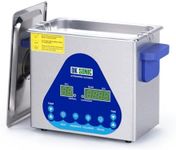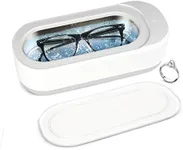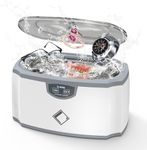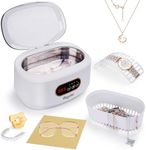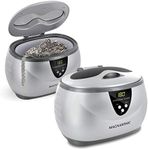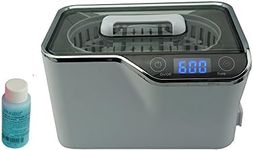Buying Guide for the Best Ultrasonic Eyeglass Cleaners
Ultrasonic eyeglass cleaners are handy devices that use ultrasonic waves to clean your glasses thoroughly and gently. Instead of scrubbing your lenses by hand, these machines use high-frequency sound waves to create tiny bubbles in water or cleaning solution, which then remove dirt, oils, and grime from every nook and cranny. When choosing the right ultrasonic cleaner, it's important to understand the key features that affect cleaning performance, ease of use, and suitability for your specific needs.Ultrasonic FrequencyUltrasonic frequency refers to how many times per second the sound waves vibrate in the cleaning tank, usually measured in kilohertz (kHz). This is important because higher frequencies produce smaller bubbles, which are gentler and better for delicate items like eyeglasses, while lower frequencies create larger bubbles that are more aggressive. Most eyeglass cleaners range from about 35kHz to 50kHz. If you have delicate coatings or want a gentle clean, look for higher frequencies (40kHz and above). For tougher grime, a lower frequency may be more effective, but it can be harsher on sensitive lenses.
Tank SizeTank size is the volume of the cleaning chamber where you place your eyeglasses, usually measured in milliliters or liters. This matters because the tank needs to be large enough to fully submerge your glasses without crowding. Small tanks (under 400ml) are compact and good for single pairs of glasses, while medium tanks (400ml–700ml) can handle larger frames or multiple items at once. If you plan to clean other items like watches or jewelry, a larger tank may be more versatile. Choose a size that fits your typical eyeglasses comfortably without being too bulky for your space.
Timer SettingsTimer settings let you control how long the cleaning cycle runs, which is important for both convenience and safety. Some cleaners have fixed timers (like 3 or 5 minutes), while others offer adjustable timers so you can select the cleaning duration. Shorter cycles are usually enough for regular cleaning, while longer cycles can help with stubborn dirt. If you want more control or plan to clean different types of items, look for a model with adjustable timer options.
Cleaning Solution CompatibilityNot all ultrasonic cleaners are designed to work with every type of cleaning solution. Some are meant for use with plain water, while others can handle mild detergents or specialized cleaning fluids. This is important because certain solutions can enhance cleaning for oily or greasy residues, but harsh chemicals may damage your glasses or the machine. Check what types of solutions are recommended for the cleaner and your eyeglasses. If you have sensitive lenses or coatings, stick to water or approved gentle solutions.
Ease of Use and MaintenanceEase of use covers how simple it is to operate the cleaner, fill and empty the tank, and keep it clean. Features like one-touch operation, clear indicator lights, and removable baskets make the process smoother. Maintenance is also important—look for tanks that are easy to wipe out and machines with accessible controls. If you want a hassle-free experience, prioritize models with straightforward controls and easy cleaning features.
Build Quality and Safety FeaturesBuild quality refers to how sturdy and well-made the cleaner is, which affects its durability and safety. Stainless steel tanks are more durable and easier to clean than plastic ones. Safety features like automatic shut-off, non-slip feet, and overheat protection can prevent accidents and extend the life of the device. If you plan to use the cleaner frequently, or if you want peace of mind, look for solid construction and built-in safety mechanisms.
